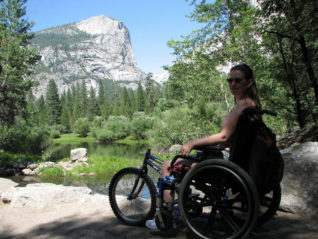One appeal of hiking is that it combines exercise with getting out in nature, which provides a break from regular routines and a way to unplug. There are many trails, for handicapped hiking, that accommodate all levels of ability. A few things to consider when assessing the accessibility of a trail for handicapped hiking:
- Distance
- Surface type
- Obstacles
- Trail width
- Obstructions
- Grade
- Cross slope
Wheelchairs for Handicapped Hiking
Depending on the trail, more rugged wheelchairs and handcycles make hiking more accessible. These usually have mountain-bike-style tires (and others offer treads) on three, four or five wheels depending on chair model.
Benefits of Hiking
“Research shows that hiking has a positive impact on combating the symptoms of stress and anxiety. Being in nature is ingrained in our DNA, and we sometimes forget that.”
– Gregory A. Miller, PhD, president of the American Hiking Society
Find an Accessible Trail
Below are links that have directories of accessible hiking trails.
Offers users the ability to search trails by city, state or zip as well as by “accessible” to find disabled-friendly trails across the United States. It provides trail guides with descriptions, photos, and reviews to help plan a hike.
FREE Lifetime Pass to National Parks and Federal Recreational Lands
The America the Beautiful Access Pass, otherwise known as the National Parks and Federal Recreational Lands Pass, is a free lifetime pass available to US citizens (or permanent residents of the US) who have been medically determined to have a disability.
Additional Resources
You might also be interested in Tips for Camping with a Disability.


Leave a Reply